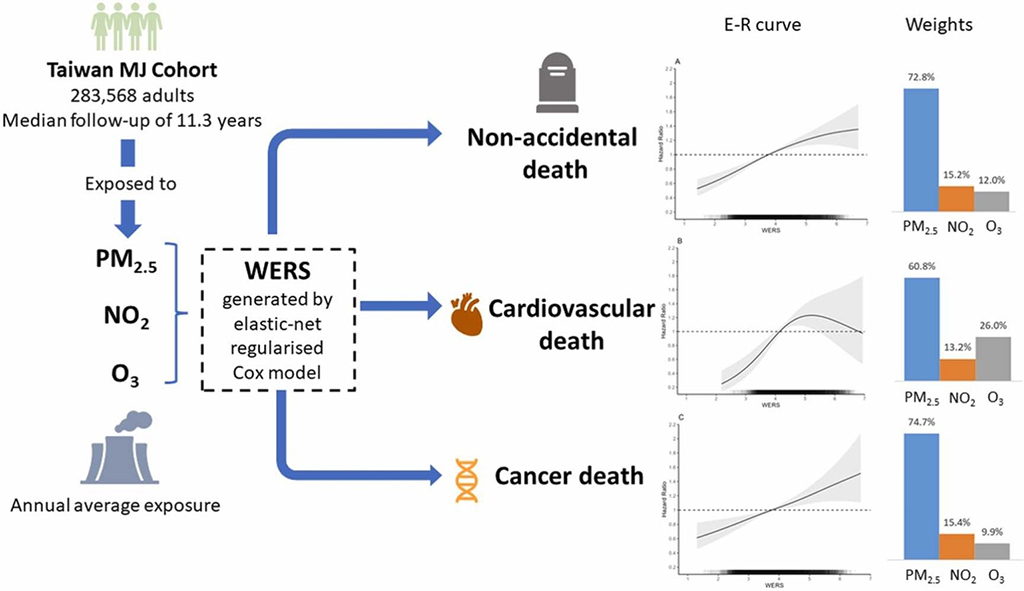
A pivotal study published in the Journal of Hazardous Materials has unveiled significant insights into the individual contributions of fine particulate matter (PM2.5), nitrogen dioxide (NO2), and ozone (O3) to the risk of non-accidental, cardiovascular, and cancer mortality. This pioneering research sponsored by Hong Kong Research Grant Council (RGC)- General Research Fund (GRF) not only clarifies the relative dangers of these pollutants but also underlines the urgency for a coordinated approach to air quality management.
Researchers from top universities/research institutes across Hong Kong and Taiwan conducted this large study over 12 years from 2005 and 2016 with 283,568 adults in Taiwan. They meticulously quantified the weight of each pollutant's contribution to health risks based on a standard deviation (SD) increment, found that PM2.5 had the most significant impact across all mortality outcomes. NO2 followed closely, ranking as a significant second contributor to non-accidental and cancer mortality risks. Notably, O3 was identified as a critical factor in increasing cardiovascular mortality risks, positioning itself as the second major contributor in this category.
Implications for Public and Environmental Health Policy
“Our findings provide a quantifiable assessment of how individual air pollutants contribute to mortality risks, paving the way for more targeted and effective pollution control policies,” stated Professor Lao Xiang Qian, the Principal Investigator of the RGC-GRF sponsored project from the Department of Biomedical Sciences, City University of Hong Kong. “By quantifying the exact contribution of each pollutant, policymakers can implement specific strategies that directly address the most significant threats to public health.”
The research findings not only corroborate the substantial hazards posed by PM2.5 but also highlight the notable adverse impacts of NO2 and O3. This calls for a coordinated approach to pollution control that integrates the monitoring and reduction of multiple pollutants simultaneously, to maximize public health benefits. Specifically, the study emphasizes that reducing PM2.5 emissions should remain a strategic priority for air quality management, focusing on major sources such as coal combustion and industrial emissions. Meanwhile, strategies for controlling NO2 emissions should target key contributors such as vehicle emissions and power plants. Given that O3 formation is catalyzed by the interaction of volatile organic compounds (VOCs) and nitrogen oxides (NOx) under sunlight, efforts to mitigate O3 pollution should include regulating VOC emissions from industrial activities and urban traffic.
Potential Impact on Hong Kong
Although the study was conducted with residents in Taiwan, its findings hold significant relevance for Hong Kong—a city with a similar Chinese cultural and genetic backdrop and where air pollution is a persistent public health issue. Over the past decade, efforts by the Hong Kong government have led to a decrease in PM2.5 levels, mirroring trends observed in Taiwan and some developed economies. However, unlike PM2.5, O3 levels in Hong Kong have not shown a significant downward trend, primarily due to the complex processes involved in its formation. Additionally, the concentration of O3 is expected to rise further, exacerbated by the projected increases in temperature due to climate change.
Professor Lao Xiang Qian, the senior author of the paper and a member of the Air Science and Health Task Force at the HK government, which is involved in the review and development of HK Air Quality Objectives, emphasizes, “This research underscores the urgent need for the Hong Kong government to allocate more resources towards investigating the local sources of O3 and developing effective strategies to control it, while continuing to prioritize PM2.5 reduction.” To tackle these challenges, it is critical for policy measures to focus on reducing emissions from key sources of NOx and VOCs, such as vehicular traffic and industrial activities, which contribute significantly to O3 formation.
“The joint effect of long-term exposure to multiple air pollutants on non-accidental and cause-specific mortality: A longitudinal cohort study” is published on 7 May 2024. Full text is available at: https://doi.org/10.1016/j.jhazmat.2024.134507